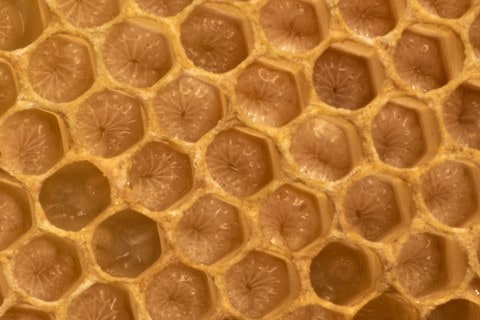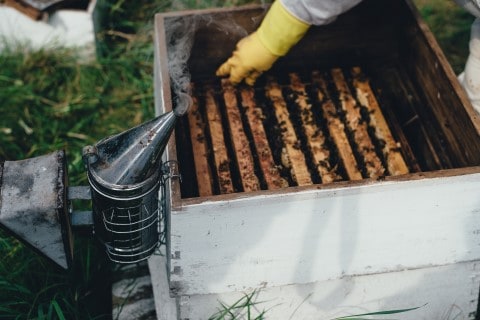When we think of beehives we sometimes think of a little hive dangling from a tree, the kind from cartoons that bears like Winnie the Pooh would go swat-at or we picture one of those small artificial set-ups beekeepers make so that it is easier for them to gather honey. Well, while plenty of smaller beehives like those do exist, it is possible for beehives to not just be large, but absolutely massive. It is worth differentiating how some beehives are purely natural like the kind thought-of a hanging off a tree and other beehives are, “Artificial,” in that they are initially human-made structures that are then purposely (or sometimes accidentally) populated with bees.
Therefore, before we discuss some of the World’s largest beehives it is important to talk about how large natural and artificial hives generally get so that you’ll have a idea just how impressive the big ones truly are…and the unexpected place some of these biggest hives have formed.
Table of Contents
How Large do Beehives Get Naturally?
A group of bees is known as a colony and a hive or beehive is what you call the place they live. Hence, a colony is what constructs a natural beehive.

These beehives that are wholly created by bees tend to be basically one big massive piece of wax full of intricate structures that allow the bees to store food, care for young, and keep warm when the outside temperature is too cold to leave the hive (which makes storing a bunch of honey during the warmer months extremely important.
Did you know? A natural beehive can grow large enough to weigh approximately 110 pounds and be made-up of 60,000 individual bees!
Worker bees have glands that produce the wax through the process of their body transforming honey that eat into the wax–it then literally comes out their pores, is chewed by the bees (kind of like you chew gum) and they used as a construction material wherever the bees have chosen to start building a hive (on a tree, in a rock crevice, and so forth). Also, they are not as readily easily seen, but sometimes bees will build hives underground in old animal burrows or within caves.
How Large Can a Beehive Get Artificially?

Did you know? Artificial settings such as Langstroth hives can weigh up to 350 pounds and hold a colony of 60,000 individual bees.
Artificial beehives are generally made out of a Langstroth Hive. These are the kind of hives you’ve most likely seen on television that look like strange boxes with slots to insert and pull-out long trays (which of course hold honey). Sometimes bees have made their hives in artificial structures that were never intended to be a home for bees (more on these massive hives later).
How Long Does it Take for a Beehive to Reach “Full” Size?
As you maybe have noticed from the section about natural and artificial hives, they seem to max-out around 60,000 bees, regardless of if there is more space and weight such as in some artificial structures that allow lots of building and honey production or if it is a wholly natural hive.
Why do beehives generally seem to stop growing?
Well, a hive simply can become too big and go from being beyond full to overcrowded AKA a, “Swarm.” A swarm is basically a large group of bees with a queen in search of a new space to build a hive. Should a current hive simply get too large a new one will strike-out and form.
As for how long it can take an initial hive to reach its, “Full,” size this can honestly vary. With the perfect temperature, weather, food availability, and generally favorable conditions you could see a hive reach that 60,000 mark in as few as six weeks in theoretically, “Perfect,” situation. However, because weather can change, illness can strike, and other factors sometimes a hive will never grow that large or a hive with limited space might top-out at a colony of 3,000 bees in a natural hive weighing 35 pounds (with any kind of larger populating resulting in a swarm heading-out. So, it is basically impossible to give a general answer of how long it takes for a beehive to reach a peak size as conditions can vary. However, when the conditions are just right some incredible hives can form.
What are the World’s Largest Beehives?
While a bee colony might generally not exceed 60,000 in terms of the actual numbers of bees, if they have the space available and the circumstances are just right mega-hives have been found to form that are almost like a bunch of smaller hives so close together it is like one monstrous creation.
In Houston there was a house with a beehive inside its walls that was two stories tall and thought to hold somewhere between 200,00-500,00 bees total! They simply just kept growing-out in the hollow walls of the house that allowed this huge hive to form. Human households can make great homes for bees with lots of hollow areas and consistently warm temperatures in the winter.
In Utah a hive that was 12 feet long, 4 feet wide, and 16 inches deep was cleared-out in 2013 after it started forming in 1996 in the house’s eaves–the owners did not worry about until it at first because they used the location more as a vacation-home and did not notice it was clearly an issue some years later when they started using the house more and noticed there were a lot of bees. Despite its massive size, the colony itself was the usual-maximum of around 60,000, it had just taken advantage of all the wonderful space available to grow the hive itself well beyond the normally-seen size.
This is not to say it is unheard of for some natural hives to exceed the usual expected limits. In Virginia a massive, “Open”, beehive was once found having grown into a huge chain-link fence, but these natural hives of a large size tend to be extremely rare and still do not match the kinds of hives that have been found in people’s homes. There is not an official record as of yet for the World’s largest artificial hive, but basically if the conditions are right, the World’s largest beehives tend to be found unwittingly within the homes of humans!
Can Beehives Keep Growing Larger As they Age?
As was touched-upon, sometimes a beehive will top-out at a smaller natural size. With that said, theoretically if a beehive that is at first smaller does have the chance to grow and fit more bees in its colony without a space issue, such a thing could occur for sure. A beehive in a location that for two years has brutal winters might stay relatively small for the sake of efficiency, but then suppose an abnormally warm Fall and Winter occurs that results in a lot of leftover honey and provides the bees with ample resources to build-out their hive come the Spring? Well, that small hive may very well find itself growing –but not so much due to age as the fact that there was an opportunity for growth. In this same manner of course, a massive die-off of bees from a brutal winter could result in a hive basically, “Shrinking,” as large areas find themselves no longer inhabited and colony instead shrinks to a very small size (it is possible to go from a hive of 60,000 to just 1,000 for a period of time) and less of a massive hive is therefore used until possibly in the future when a colony could grow again. It is not so much the age of a hive that matters as it is the strength of the colony within it.
What is the World’s Oldest Beehive?
As colonies within a hive can grown and shrink it stands to reason there could be hives that have stood the test of time and been around for quite a long while. Beehives can last for years and there are even records of some lasting centuries. One beehive that existed as long ago as 1880 that had built itself into a colonial home was actually uprooted and relocated when the home’s current owner was advised letting the bees continue to live within the hollow wood of the house put it at great risk due to its old age.
As for the oldest beehives ever found (which no longer actively house bees) there have actually been artificial hives found within Israel that can be traced back 3,000 years or more. This means that we as human beings have loved caring for bees (and enjoying their delicious honey) for millenniums! Even though there is not 3,000 year-old beehive that has consistently had bees in it is still impressive to think thousands of years ago humans were caring for bees just as we are today (albeit with some advances in technology that make it a bit easier)!
Summary
Bee colonies usually tend not to exceed 60,000 bees and around 110 pounds if natural and maybe 350 pounds if in an artificial hive. With that said however, sometimes certain conditions exist that allow a colony of 60,000 bees to really spread-out and take-up more space, or a number of smaller hives might be in such close proximity it is like one massive mega-hive. These hives seem to generally form in the homes of people who don’t realize just how quickly a tiny hive can grow in the right circumstances (like spacious walls in a warm and dry house), so with the knowledge that the biggest hives tend to be found within human dwellings that were unprepared to keep bees out you know both know how impressive and resourceful bees are when it comes to making their hives!
Sources
https://www.orkin.com/stinging-pests/bees/how-do-honeybees-make-hives
https://carolinahoneybees.com/what-is-a-beehive/
https://hinterlandbees.com/news/2018/12/14/how-big-can-a-bee-hive-get
http://www.southeastbeeremoval.com/blog/125-year-old-bee-hive-gets-change-of-address
https://www.wired.com/2010/06/ancient-bees/
https://www.foxnews.com/science/rare-open-beehive-in-virginia-stuns-wildlife-expert
https://www.livescience.com/29438-huge-utah-beehive-honeybees.html

After read a couple of the posts on your website now, and I truly like your way of blogging. I tag it to my favorites site list and will be checking back soon. Please visit my web site too and let me know what you think.